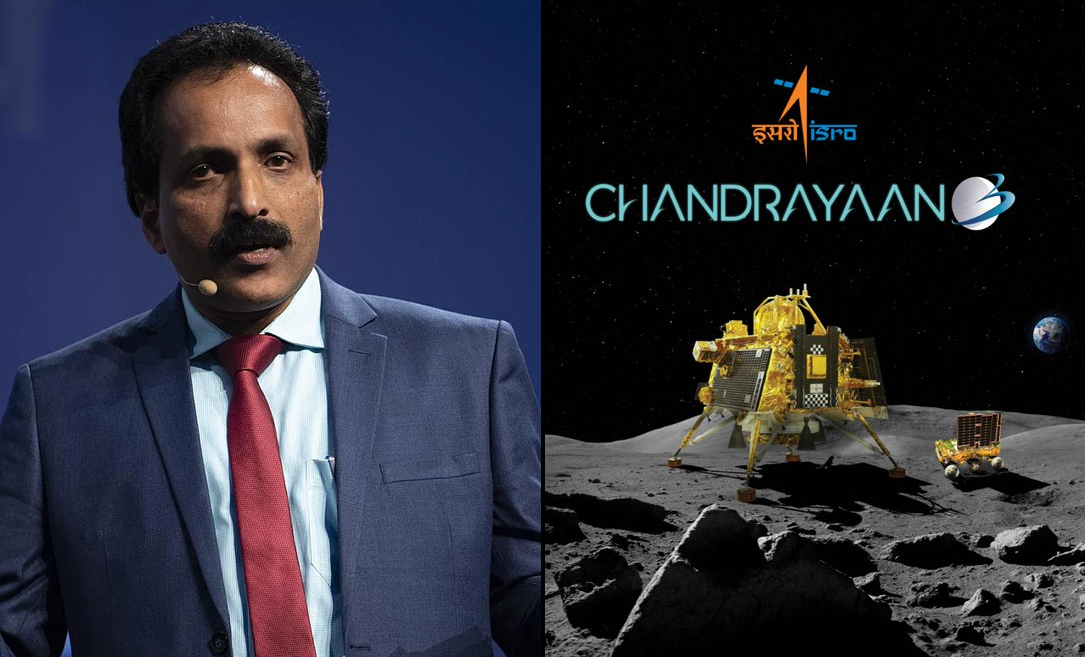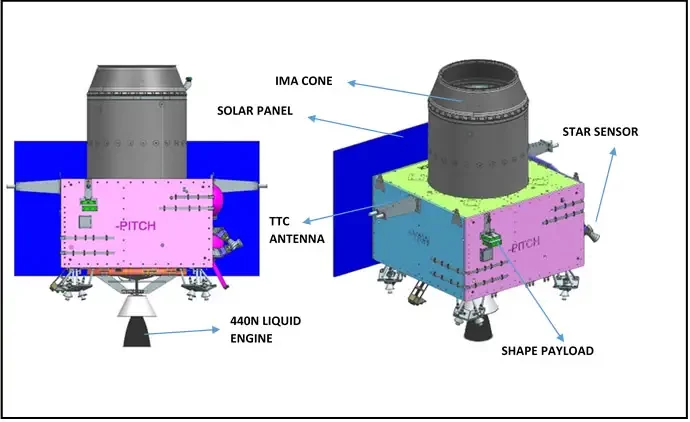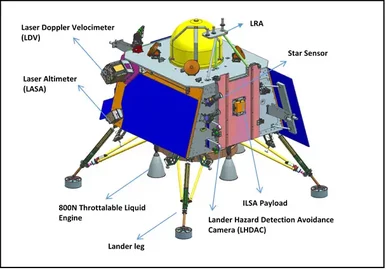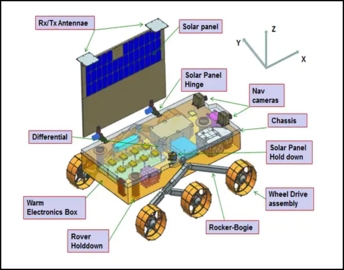In the realm of space exploration, India has once again etched its name with the resounding success of the Chandrayaan-3 mission. This mission, a part of the esteemed Chandrayaan programme by the Indian Space Research Organisation (ISRO), is the third chapter in India’s lunar exploration journey.
Launched on July 14, 2023, Chandrayaan-3 comprises a lander named Vikram and a rover named Pragyan, following in the footsteps of the Chandrayaan-2 mission. The mission’s propulsion module played a crucial role in transporting the lander-rover duo to a designated lunar orbit, meticulously paving the way for a powered descent.
The crowning glory of Chandrayaan-3’s accomplishments came on August 23, 2023, at 18:02 IST, when the Vikram lander and Pragyan rover executed a soft landing near the lunar south pole region.
This remarkable feat has positioned India as the first nation to successfully land a spacecraft near the lunar south pole and the fourth globally to achieve a soft landing on the Moon.
Historic day for India’s space sector. Congratulations to @isro for the remarkable success of Chandrayaan-3 lunar mission. https://t.co/F1UrgJklfp
— Narendra Modi (@narendramodi) August 23, 2023
Unraveling Lunar Mysteries: Mission Objectives
At the heart of the Chandrayaan-3 mission lay a trio of ambitious objectives:
- Precision Landing: The primary objective was to ensure a precise, soft landing on the lunar surface—a task that requires immense precision and meticulous planning.
- Rover Mobility and Exploration: A key focus was to demonstrate the rover’s mobility and its capability to navigate the rugged lunar terrain with finesse.
- Material Analysis: Chandrayaan-3 aimed to conduct a series of on-site experiments to meticulously analyze the composition of lunar surface materials. These experiments promise insights into the Moon’s geological history and its formation processes.
Engineering Marvels: Mission Components
The Chandrayaan-3 mission consisted of three integral components, each contributing uniquely to the mission’s success:
- Propulsion Module: Acting as the mission’s workhorse, the propulsion module deftly orchestrated the intricate journey of carrying the lander and rover to an optimal lunar orbit, situated approximately 100 kilometers above the lunar surface. Noteworthy features include its box-like structure, housing a formidable solar panel, and an Intermodular Adapter Cone—a structure designed to serve as a robust mounting point for the lander.
- Lander (Vikram): The Vikram lander was tasked with achieving a gentle, precise lunar landing. It featured an innovative design characterized by a box shape, four landing legs, and four landing thrusters capable of generating 800 newtons of thrust each. Vikram was home to an array of scientific instruments, including the Chandra’s Surface Thermophysical Experiment, the Instrument for Lunar Seismic Activity, Langmuir Probe, and a Laser Retroreflector Array.
- Rover (Pragyan): The Pragyan rover, a technological marvel, boasted a six-wheeled configuration and weighed 26 kilograms. Functioning as a scientific laboratory on wheels, Pragyan conducted a range of analyses on lunar materials. It was equipped with instruments like the Alpha Particle X-ray Spectrometer and Laser Induced Breakdown Spectroscope for comprehensive material assessment.
Leading the Way: S. Somanath
Sreedhara Panicker Somanath aka S. Somanath is a prominent Indian aerospace engineer who currently serves as the Chairman of the Indian Space Research Organisation (ISRO). Under his guidance, ISRO successfully executed the Chandrayaan-3 mission.
Somanath’s contributions extend beyond his role as Chairman. He has held significant positions at the Vikram Sarabhai Space Centre, Thiruvananthapuram, and the Liquid Propulsion Systems Centre, Thiruvananthapuram.
With expertise in launch vehicle design, including launch vehicle systems engineering, structural design, dynamics, and pyrotechnics, Somanath has been an integral part of India’s space journey.
Born in Thuravoor, Kerala, has completed his schooling at St. Augustine’s High School, Aroor, and pursued further education at Maharaja’s College, Ernakulam. His academic journey led him to a mechanical engineering degree from Thangal Kunju Musaliar College of Engineering, Kollam, Kerala University.
He further honed his skills by earning a master’s degree in aerospace engineering from the renowned Indian Institute of Science, Bangalore, specializing in dynamics and control.
Reflecting on the achievement of Chandrayaan-3, Somanath attributed this milestone to the collective efforts of ISRO’s leadership and scientists across generations. From Chandrayaan-1 to Chandrayaan-2, he acknowledged the dedication of the entire team involved in crafting these missions.
As Chandrayaan-3 takes its place in history, Somanath emphasized the importance of acknowledging and expressing gratitude to those who laid the groundwork for India’s remarkable accomplishments in space exploration.
Building on Legacy: Chandrayaan-1 and Chandrayaan-2
The triumph of Chandrayaan-3 stands on the shoulders of its predecessors. Chandrayaan-1, launched in 2008, unveiled the presence of water ice on the lunar surface, revolutionizing our understanding of the Moon.
Despite the communication loss of the Chandrayaan-2 lander during descent, the orbiter continued to operate efficiently, providing an abundance of high-definition lunar images.
Transformation Through Setbacks: Chandrayaan-3’s Genesis
Chandrayaan-3’s remarkable success was forged through the lessons gleaned from Chandrayaan-2’s challenges. Nambi Narayanan, a former ISRO scientist, emphasized the meticulous addressal and rectification of every hurdle encountered during Chandrayaan-2’s journey. These experiences fostered the refined approach that culminated in Chandrayaan-3’s triumphant lunar landing—a true testament to ISRO’s perseverance.
Global Recognition and Future Vistas
The triumph of ISRO’s third lunar mission, Chandrayaan-3, has elicited accolades and appreciation from around the world.
Prime Minister Narendra Modi lauded the soft landing of Chandrayaan-3 on the Moon, marking a momentous achievement for India’s space endeavors.
S Somanath, the guiding force behind the mission, humbly stated “Success not ours alone, this is the work of a generation of ISRO scientists”
In a gesture of international goodwill, the Dalai Lama extended his warm regards to PM Modi on the success of Chandrayaan-3. He said “the successful landing of Chandrayaan-3 is a tribute to the people of India who have devoted their attention to scientific development since ancient times.” “I would like to applaud the head of the Indian Scientific Research Organisation (ISRO) and his team for their dedication that has made the mission possible. They have demonstrated India’s scientific and technological maturity.”.
Elon Musk, the visionary CEO of Tesla and SpaceX, added his voice to the chorus of congratulations. He hailed India’s achievement, characterizing it as “super cool.” Musk’s endorsement of India’s lunar endeavors had been evident even before the successful landing, as he had previously remarked, “Good for India.”
The United States, a key player in space exploration, proudly celebrated India’s achievement. Expressing deep admiration, the sentiment echoed that this accomplishment isn’t just a milestone for India but also a moment of pride for every Indian citizen.
Kapil Sibal said “It’s a historic moment for every citizen of India”.He acknowledged that this achievement holds significance not only for the scientific community but for every citizen of the nation.
US Vice President Kamala Harris extended her hearty congratulations to India for the monumental landing of Chandrayaan-3. She tweets “It’s an incredible feat for all the scientists and engineers involved. We are proud to partner with you on this mission and space exploration more broadly,”.
Google CEO Sundar Pichai, expressing his awe, tweets “What an incredible moment! Congratulations to ISRO for the successful landing of #Chandrayaan3 on the moon. Today India became the first country to successfully achieve a soft landing on the southern polar region of the moon,“.
Karnataka Chief Minister Siddaramaiah applauded the team of ISRO scientists for their resounding success. Their dedication and expertise had culminated in a moment that filled every Indian heart with pride.
The future shines even brighter as ISRO collaborates with the Japan Aerospace Exploration Agency (JAXA) for the Lunar Polar Exploration Mission (Lupex), colloquially known as Chandrayaan-4.
In Conclusion: Pioneering the Cosmic Odyssey
Chandrayaan-3 encapsulates India’s indomitable spirit in the pursuit of scientific advancement and cosmic exploration. The triumphant landing near the lunar south pole symbolizes the harmonious collaboration of numerous scientists, engineers, and leaders who have elevated India’s space program to celestial heights.
With each mission, India charts a pioneering course into the cosmos, unraveling its mysteries and setting the stage for captivating celestial discoveries.








